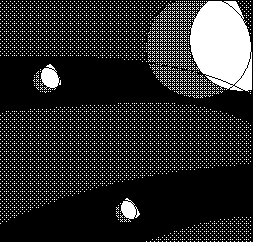This time, this page is long, talking about a way of global haiku.
When I was living in a village in Japan, a small river was flowing right
next to our house.
It was usually singing, and so clean that you couldn't scoop the river
water without getting killifish in a bucket.
This haiku brought me back to that riverside back in time.
I used to watch the river from the second floor window at night.
There were lots of fragments of the shiny moon on the surface.
The shapes were never the same, restlessly gathering and parting without
flowing away.
The river looked like it was struggling to be one with the moon
by making the fragments into one in its body.
the river
the river makes
of the moon
When I found this haiku,
because of repeating the phrase "the river," I imagined the river at
different moments:
a scene with a pattern of floating fragments of the moon,
another pattern a moment later, and next....
The picture started to move restlessly and endlessly, just like the
river in my memory.
One evening when my son was two years old, looking at the moon from
our window,
he improvised a song: "Mr. wind, Mr. wind, round, Ms. Moon... pooong!"
(It's strange in English) It didn't even make a sentence,
but I felt the feeling of the wind wanting to hug the moon.
This haiku let me recall that scene, too.
I wasn't sure of the meaning of the English phrase "make(s) of" in this
haiku;
so I asked to the author Mr. Jim Kacian if my understanding was wrong.
He gave me his permission to use his haiku through my understanding
here
together with his kind information:
"Make of" is idiomatic in englishInteresting:
we "make something of" when we imagine or create the completion of
something in our mind for example, I might think a woman has some feelings
for me, when in fact she does not it exists only in my mind,
but that might be enough for me to act on it--to make something of it.
The following was written about this haiku by Richard Gilbert :
In this unusual example, the (seeming) juxtaposition of the first-line
fragment with the following phrase is irrupted as one discovers the
first line is not the alpha but rather the omega-point of the poem
(reversing semantic expectation). A second reading may yield a sense of
three disjunct fragments without juxtaposition (a poem made only of
fragments). Considering the last two lines as the phrasal element (the
superposed section), out of what seems textually and imagistically to be
two rivers and their juxtaposition, a fusion arises as synthesis: the
naturalistic river in the second line metaphorically A*gmakesA*h of the
moon a second river (the river of the first line); finally, natural and
metaphoric images combine, resolve and fuse into the traditional image
of moon on water: moon river on A*griverA*h river. In this way, a poem
which at first glance may seem elemental, primitive and static releases
a flowing metamorphic power, quite in keeping with its riverine imagery;
a highly nuanced haiku, informing our understanding of the relationship
between realism and metaphor. Experiencing this haiku it is difficult to
understand proscriptions warning against the use of metaphor. Metaphor
has given us some of the best English haiku--usually however, metaphor
must be given through the sense of disjunction rather than through
grammar parts.
 (tree) shows a simplified
tree shape, but each individual image of a tree must not like this.
(tree) shows a simplified
tree shape, but each individual image of a tree must not like this. 
| The original haiku by Jim Kacian the river the river makes of the moon The Japanese translation by Akihiro Kitano: 月を恋う川面に遊ぶ千々(ちぢ)の光(かげ) |
The Slovenian translation by Dimitar Anakiev
: reka luna naredi reko The German translation by Dietmar Tauchner: der Fluss was der Fluss aus dem Mond macht |

 {the nature that looks
sometime
{the nature that looks
sometime  , and another
time
, and another
time  }(as the fundamental
character): the moon (月)
}(as the fundamental
character): the moon (月) {
{ place,
place,  water,
water,  flowing/wave}: river (川)
flowing/wave}: river (川) {
{ water,
water,  flowing/wave}: flowing
(of water) (流れ)
flowing/wave}: flowing
(of water) (流れ)
今回はグローバル時代の俳句の一つのあり方について書いてみました。
私がかつて日本で暮らした村の家の横には小川が流れていました。
せせらぎの音がいつも聞こえ、バケツで水を汲もうとすると、
メダカを掬わずには汲めないようなきれいな流れでした。
この俳句は、時を飛び越えて私をこの川辺に連れ戻しました。the river
the river makes
of the moon
砕かれた月影が、一刻も早く元の満月になりたい、という もだえ
原作者とは、違う内容かもしれませんが、
この 恋 は、一緒になりたい という
つまり、砕かれた月影が、一刻も早く元の満月になりたい、という
もだえ のような気持ち、と私は、勝手に想像しました。